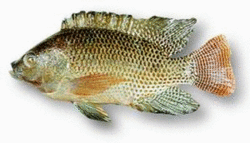<!--
<!--<!--[if gte mso 10]> <style> /* Style Definitions */ table.MsoNormalTable {mso-style-name:"جدول عادي"; mso-tstyle-rowband-size:0; mso-tstyle-colband-size:0; mso-style-noshow:yes; mso-style-parent:""; mso-padding-alt:0cm 5.4pt 0cm 5.4pt; mso-para-margin:0cm; mso-para-margin-bottom:.0001pt; mso-pagination:widow-orphan; font-size:10.0pt; font-family:"Times New Roman"; mso-ansi-language:#0400; mso-fareast-language:#0400; mso-bidi-language:#0400;} </style> <![endif]-->

FAO Tilapia as it
The culture of Nile tilapia (Oreochromis niloticus) can be traced to ancient Egyptian times as depicted on bas-relief from an Egyptian tomb dating back over 4000 years, which showed the fish held in ornamental ponds. While significant worldwide distribution of tilapias, primarily Oreochromis mossambicus, occurred during the 1940s and 1950s, distribution of the more desirable Nile tilapia occurred during the 1960s up to the 1980s. Nile tilapia from Japan were introduced to Thailand in 1965, and from Thailand they were sent to the Philippines. Nile tilapia from Cote d'Ivoire were introduced to Brazil in 1971, and from Brazil they were sent to the United States in 1974. In 1978, Nile tilapia was introduced to China, which leads the world in tilapia production and consistently produced more than half of the global production in every year from 1992 to 2003. The uncontrolled breeding of tilapia in ponds, which led to excessive recruitment, stunting and a low percentage of marketable-sized fish, dampened the initial enthusiasm for tilapia as a food fish. The development of hormonal sex-reversal techniques in the 1970s represented a major breakthrough that allowed male monosex populations to be raised to uniform, marketable sizes. In addition, research on nutrition and culture systems, along with market development and processing advances, led to rapid expansion of the industry since the mid 1980s. Several species of tilapia are cultured commercially, but Nile tilapia is the predominant cultured species worldwide.
Cages vary widely in size and construction materials. In Brazil, cage volumes and stocking densities range from 4 m3 cages stocked at 200-300 fish/m3 to cages 100 m3 or larger stocked at 25-50 fish/m3. Yields range from 50 kg/m3 in 100 m3 cages to 150 kg/m3 in 4 m3cages. In Colombia, cages range from 2.7 to 45 m3 in volume and are stocked with 30 g sex-reversed male fingerlings and raised to 150-300 g in 6-8 months. The fish are fed extruded feeds with 24-34 percent crude protein. Streptococcal infections are a problem, and survival averages% 65. Annual yields at final densities of 160-350 fish/m3 are 76-116 kg kg/m3.
The maximum tilapia density in raceways ranges from 160-185 kg/m3, and maximum loading ranges from 1.2-1.5 kg/litre/min. A common production level in raceways is 10 kg/m3/month, as water supplies are often insufficient to attain maximum rates. Production levels are considerably lower in tanks with limited water exchange, but water use efficiency is much higher in these systems.
Production levels in recirculation systems range from 60 to 120 kg/m3 of rearing tank volume, or more. However, the final standing crop is not the best indicator of system efficiency; the maximum daily feed input to a system is a better indicator of both productivity and efficiency. Feed input and other factors that promote production are captured by the production to capacity ratio (P/C), the ratio of system output to maximum carrying capacity. For tilapia, P/C ratios of >4.5 are possible and ratios of >3 may be necessary for profitability. Intensive stock management practices, such as multiple cohort culture with regular partial harvests and restocking, are needed to reach high P/C ratios.
Production rate of tilapia oweing to FAO
50 kg/m3 in cages
160-185 kg/m3 raceways
60 to 120 kg/m3 of tank
يمكن متابعة اخر أخبار المزارع السمكية و السمك و الدخول فى حوار مع افراد مجموعة (المزارع السمكية Aquacultures)على الروبط:
http://www.facebook.com/groups/210540498958655/
http://kenanaonline.com/hatmheet
http://kenanaonline.com/users/hatmheet/posts
https://twitter.com/shihab2000eg


ساحة النقاش